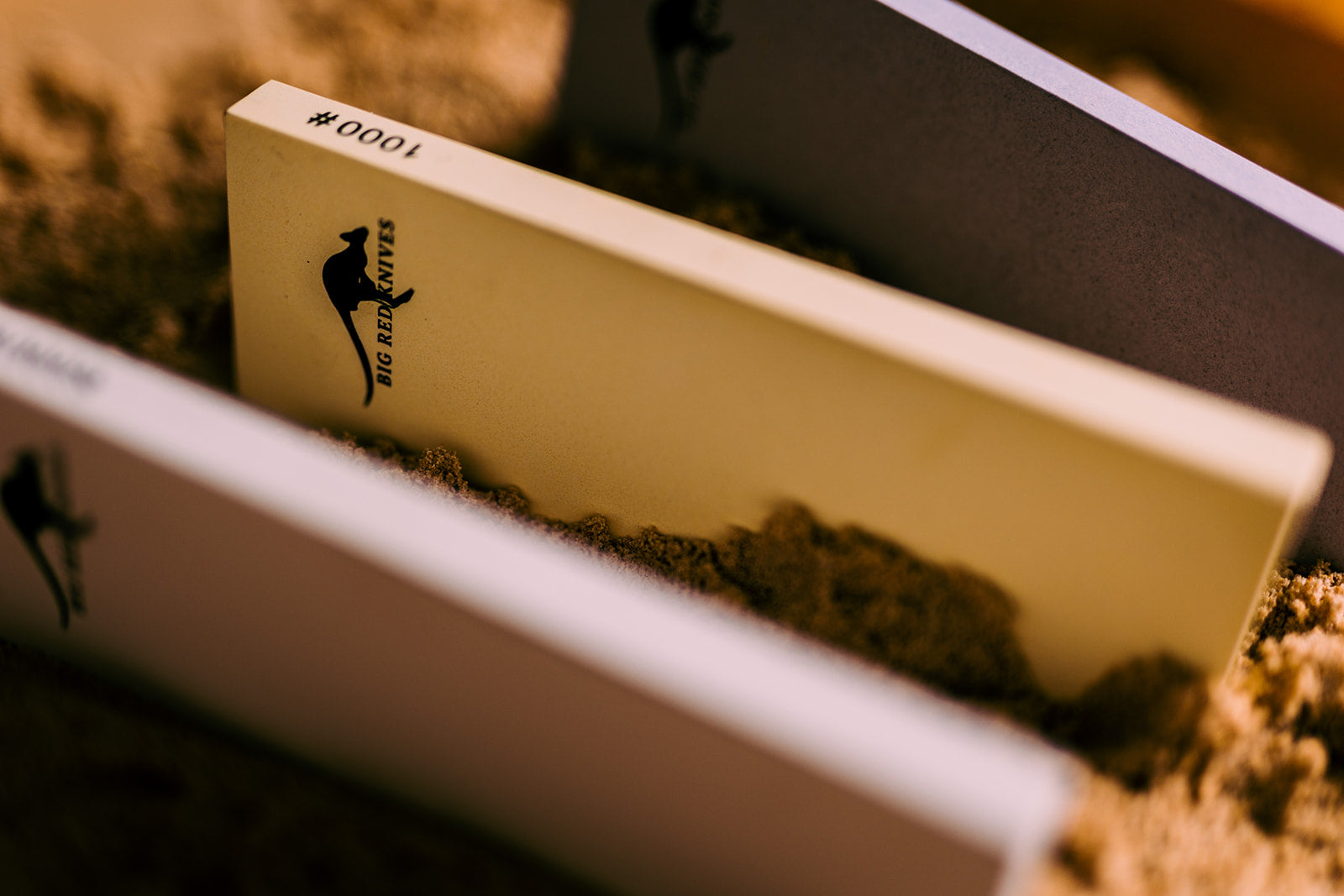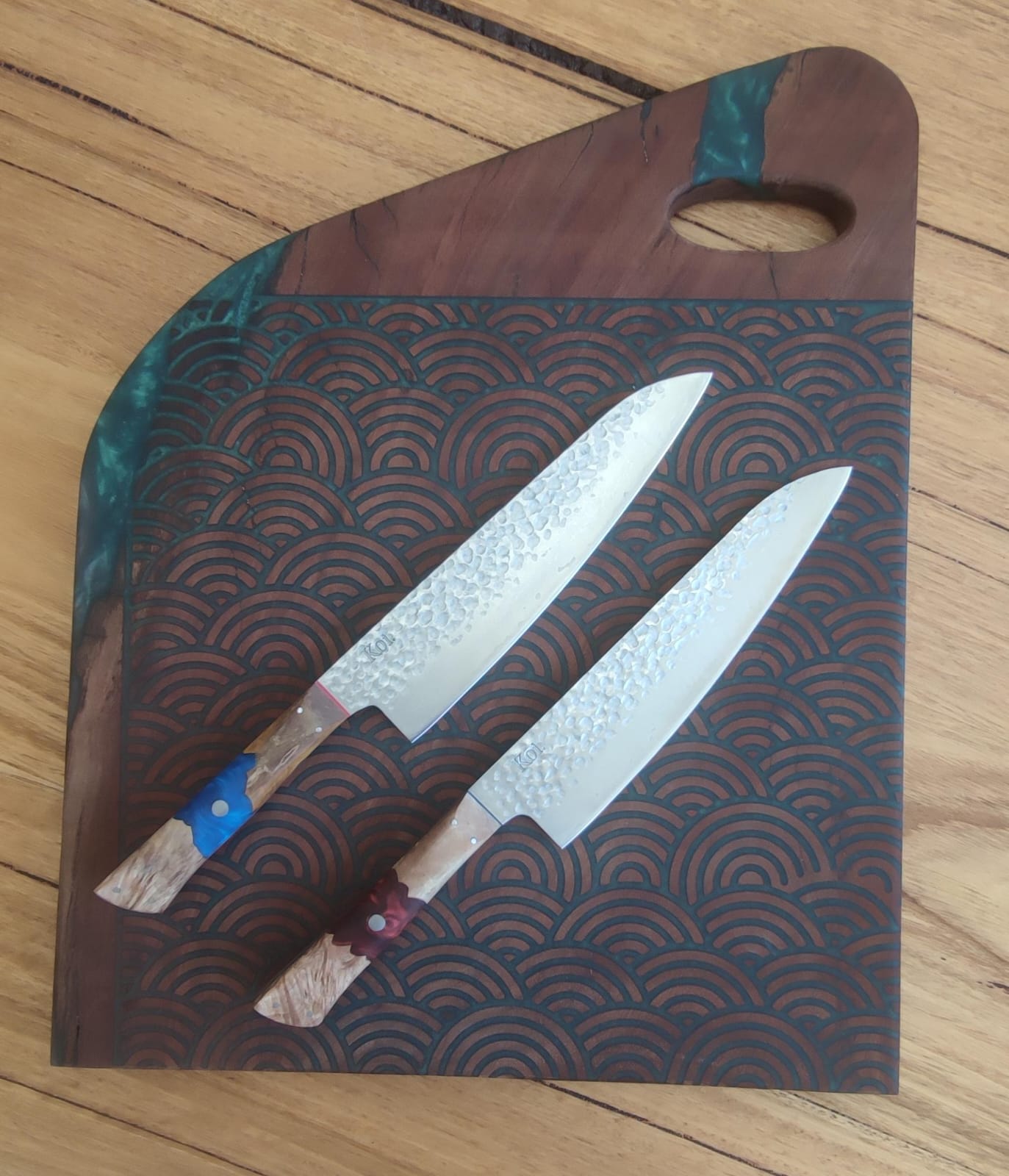Your kitchen heroes deserve more than a quick rinse. Let's uncover the secrets to keeping your knives as sharp as your culinary skills. Ever heard of the whetstone? It's a game-changer, but many folks need help using it.
Before you jump in, let's chat about the usual mistakes. We want your knives to be superheroes, not losers. Ready to make them shine?
Choosing the Right Whetstone
Coarse grits, with lower numbers, act as the restoration expert, fixing nicks and dents in your blade. As we ascend to finer grits, the polishing process begins, revealing a sharpness that's nothing short of culinary perfection.
A coarse-grit whetstone, say around 240, is your go-to for initial repairs. It’s the heavy lifter, reshaping your blade's edge. Move on to a finer grit, like 1000 or even 6000, for that final touch of finesse. It’s the subtle stroke that brings out the brilliance of your knife.
Whetstone Selection Criteria
Just as a sommelier pairs wine with a dish, match your whetstone to your knife. Consider the steel type, the extent of dullness, and your desired sharpness. A delicate Japanese chef's knife may crave the caress of a higher grit, while a robust German blade might prefer starting with a coarser option.
Frequent Errors in Whetstone Sharpening
Navigate potential challenges with finesse as we delve into key pitfalls, starting with angles and pressure precision. Learn to avoid common errors and ensure your blades meet the whetstone with expertise.
Angles and Pressure Precision
Maintain a Consistent Angle
Begin by adhering to your knife manufacturer's angle recommendations. If it suggests 20 degrees, stick to that throughout the sharpening process.
Tips for Angle Precision
Visualize your knife's edge forming a 'V,' with the angle at the center. This mental guide ensures uniform strokes.
Balancing Pressure
When applying pressure to the knife, achieve a firm handshake touch—gentle yet solid.
Avoiding Dents and Uneven Sharpening
Consistently maintaining the angle acts as a shield against dents. Ensure the blade meets the whetstone evenly for a smooth sharpening process.
Optimal Pressure Techniques
Treat your blade with the precision of a skilled artisan. Apply gentle, even pressure during each stroke, creating a consistent rhythm.
Mastering the art of maintaining the right angle and pressure demands practice. Enjoy the process; soon, you’ll be in harmony with your knife and whetstone.
Soaking or Lubrication Oversight
So, you've mastered the art of angles and pressure. Now, let's talk about another critical step – soaking and lubrication. It might seem like a small detail, but trust me, it matters.
Soaking Techniques
For water stones, patience is vital. Immerse your whetstone in water for the recommended time. It's like letting your tea steep; the stone needs time to absorb the water fully. On the other hand, if you're working with an oil stone, it's all about the proper lubrication.
Duration for Water Stones
Now, how long should you soak? Well, that depends on the specific stone, but a good rule of thumb is about 10 to 15 minutes. You want that stone to be saturated, ready to work its magic on your blade.
Lubrication for Oil Stones
If oil stones are your tool of choice, apply the right lubricant. Just a touch, don't drown it. Think of it like adding a bit of oil to a squeaky door hinge – enough to make things smooth without creating a mess.
Consequences of Neglect
Here's the crucial part: what happens if you skip this step? Your sharpening efficiency takes a nosedive. Neglecting soaking or lubrication not only affects the effectiveness of the process but also shortens the life of your whetstone and, in the long run, your beloved knife.
Progression Neglect and Dealing with Burrs
Whetstone sharpening is like sculpting a masterpiece; you wouldn't skip the detailing, would you? Grit progression is your roadmap – starting with the coarse and gradually climbing to the fine.
Grit Progression Strategy
Begin with a coarse grit to reshape and repair your blade's edge. It's the heavy lifting phase, like chiseling away the unnecessary bits. Once you've got the foundation, move on to finer grits. This is where the magic happens. The finer grits polish your blade to a razor's edge, refining it with precision.
Attending to Burrs
Now, let's talk about burrs – those tiny, often underestimated imperfections. Detecting them is like running your fingers over a smooth surface; you'll feel the bumps. Use a finer grit to gently remove these burrs. It's the final touch, ensuring your edge is sharp and impeccably smooth.
Don’t rush this process; this seemingly minor step is significant, transforming a sharp blade into a refined, edge-to-edge perfection.
Rushing the Sharpening Process
The Virtue of Patience
Sharpening your knife is a deliberate journey. Embrace the virtue of patience to ensure a meticulous process, leading to a sharper, more durable edge. Resist the urge to hurry, as each stroke on the whetstone contributes to a finely honed blade.
Avoiding Uneven Sharpening
Uneven sharpening is a pitfall of haste. Rushing can result in inconsistent angles, rendering your efforts ineffective. Patience allows for the careful repetition of strokes, ensuring that every part of the blade receives equal attention, promoting uniform sharpness.
Preventing Potential Knife Damage
Impatience can be a silent saboteur, potentially damaging your cherished knife. Hastily applied pressure or erratic strokes may lead to nicks and chips, diminishing the knife's effectiveness. Take your time safeguarding your investment and preserving the integrity of the blade.
Benefits of Time Investment
Investing time in the sharpening process pays dividends in the form of consistent angles and superior results. Patience allows the blade to naturally adapt to the sharpening motion, achieving a refined edge that glides effortlessly through ingredients.
Sharpening Tools and Accessories
So, you've grasped the nuances of sharpening. Now, let's talk about tools. An essential whetstone set is your culinary sidekick. Choose wisely — it's the backbone of your knife-care routine.
Recommended Grit Levels
Grit matters. For repairs, start coarse (around 240), finesse with a 1000, and if you seek razor-sharp, finish at 6000. Each grit has a role; skipping steps is like omitting ingredients in a recipe.
Proper Use and Maintenance
Respect your whetstone. Soak it right (if it's water-based) and lubricate it (if it's oil-based). A well-maintained stone reciprocates with longevity and sharp results.
Whetstone Sharpeners
Choosing stones isn't a guessing game. Know your needs — soft steel prefers harder stones, and vice versa. Match the stone to the knife; it's the harmony your blades crave.
Knife Sharpening Classes
If your kitchen knife loses its precision, our Knife Sharpening Classes are your gateway to culinary excellence. Master the art of sharpening knives on Japanese whetstone with Joao Sundfeld, our resident sharpener extraordinaire.
Benefits of Taking a Sharpening Class
Discover the advantages of a sharp knife that goes beyond mere convenience. A well-honed blade ensures safety in the kitchen by reducing the likelihood of slips and promotes precision, allowing your ingredients to cook evenly.
Overview of Class Structure
Our 1.5-hour classes provide a hands-on experience in a safe and instructive environment. Joao Sundfeld, specializing in single- and double-bevel sharpening, repairs, and restorations, guides you through the nuances of knife maintenance. Bring your favorite knife, and we'll equip you with a set of whetstones for continued practice at home.
Sharpen Safely: Tips for Your Kitchen Journey
As you embark on this journey, keep these safety tips in mind:
- Protect your fingers from the blade.
- Consider wearing kitchen gloves.
- Secure the whetstone properly.
- Maintain a safe distance when using a honing rod.
- Clean your tools thoroughly post-sharpening.
Ready to sharpen like a pro? Explore our upcoming sharpening classes, where you'll unravel the mysteries of knife sharpening and gain hands-on expertise. Secure your spot now for a sharper, safer kitchen experience.




